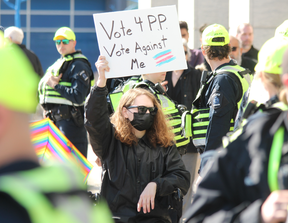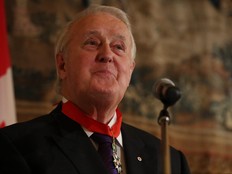Protests fuel increase in use of special Ontario police units: Report
Public order units at 11 Ontario police forces are being deployed more often as protests increase, a new report says

Article content
Global issues are fuelling protests across Ontario and putting a strain on police forces monitoring the demonstrations, a new report says.
International conflicts, the COVID-19 pandemic and other large-scale public events led to a 184 per cent increase in the deployment of public order unit police units between 2018 and 2022, the report from Ontario’s Inspectorate of Policing found.
Recommended Videos
Ryan Teschner, Ontario’s first inspector general of policing, examined the state of public order police units – specialized teams that manage crowds during major events – in his agency’s first spotlight report.
“Issues around the globe manifest themselves through our local communities and, perhaps in policing, there’s no greater example of that than public order policing,” said Teschner, whose office monitors police as well as police board performance and promotes public safety improvements.
“So we have to get real about the resource demands and strain, especially when we’re noticing increasing demands for this function and increasing complexity in relation to how it’s being delivered,” he said about public order unit deployments.
There are 11 police forces in Ontario with public order units, including London and Windsor, and they are required to deploy those officers to assist other police services that request them.
The units consist of a supervisor and at least four squads of seven officers, including a squad leader, and must be able to deploy within a reasonable time under standards set by Ontario’s Ministry of the Solicitor General.
Teschner’s inspection team spent 10 months analyzing information, data, documents, policies and procedures and conducting interviews and inspections at 44 Ontario police forces.
“I want to empathize that my overall conclusion is that the state of public order policing in Ontario is strong,” he said.
The legal infrastructure, policies and procedures are in place, Teschner said, adding that police forces are providing the necessary training to their officers who are handling requests for assistance properly.
The 57-page report highlights the risks and complexities of policing protests and other large gatherings.
“The system is becoming stretched because of the demand and because of the increasing complexities of these events, many of which are unplanned and don’t provide police services with a lot of time in order to effectively mobilize,” Teschner said. “So, we need to ensure that every police service is ready for how world events create local impacts.”

In London, the public order unit was deployed 20 times in 2024 to events including protests, both large and small, and street parties, Insp. David Ellyatt said.
“The past few years have seen a significant rise in protest as the IG report has indicated. Much of this is due to geopolitics and not specifically to local issues,” Ellyatt wrote in an email.
All members of the public order unit receive basic training in crowd management and ground search. Some officers undergo additional specialized training in crowd psychology and management tactics, formations and using less-lethal munitions, Ellyatt said.
Teschner’s report makes a handful of recommendations for public order units:
- Establish in law the hub system for co-ordinating deployments and sharing intelligence.
- Create a standardized risk assessment tool to guide deployments locally.
- Formalize collaboration with other emergency services for joint training.
- Expand training for officers to include community-specific and culturally sensitive approaches.
- Require police to provide annual updates on deployments, trends and cost to local forces.
Teschner, a lawyer who has served as executive director of the Toronto police board, was appointed in March 2024 to a five-year term as Ontario’s first inspector general of policing, a new oversight role created under the Community Safety and Policing Act. This legislation replaced the Police Services Act.













Postmedia is committed to maintaining a lively but civil forum for discussion. Please keep comments relevant and respectful. Comments may take up to an hour to appear on the site. You will receive an email if there is a reply to your comment, an update to a thread you follow or if a user you follow comments. Visit our Community Guidelines for more information.